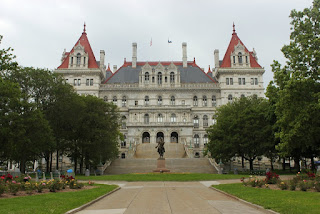Albany sits on the Hudson River 140 miles north of New York City and 10 miles south of Waterford. Founded as a Dutch trading post in 1614, it became the capital of New York in 1797 and is the longest continuously chartered city in the U.S. Albany was the original eastern entry to the Erie Canal and prospered as a center of transportation, exporting beer, lumber, and ironworks. It was one of the first cities in the world to have publicly installed water and sewer mains, natural gas lines and electricity.
Our first stop was the Visitors Center where we viewed exhibits of the history of Albany. Then we drove down into the heart of the city and parked in front of the State Capitol building. Being Sunday and Father's Day and with the sky threatening rain, there were very few people around. The current capitol building, finished in 1899, took 32 years to complete and was the most expensive capitol ever constructed at that time.
 |
| NY State Capitol Building, front view |
 |
| NY State Capitol Building, side view |
The Albany Institute of History & Art is nearby, and we saw several excellent art exhibits, including The Making of the Hudson River School and The Legacy of Currier & Ives.
Next to the capitol is the Empire State Plaza, dedicated in 1973 under the leadership of Gov. Nelson Rockefeller. It looks out over the city towards the Hudson, is centered on a long reflecting pool, and is surrounded by government offices and The Performing Arts Center, affectionately named "The Egg" for its shape. Surprisingly, The Egg contains both 450 and 952 seat amphitheaters.
 |
| Empire State Plaza reflecting pool |
 |
| The Performing Arts Center, called "The Egg" |
No comments:
Post a Comment